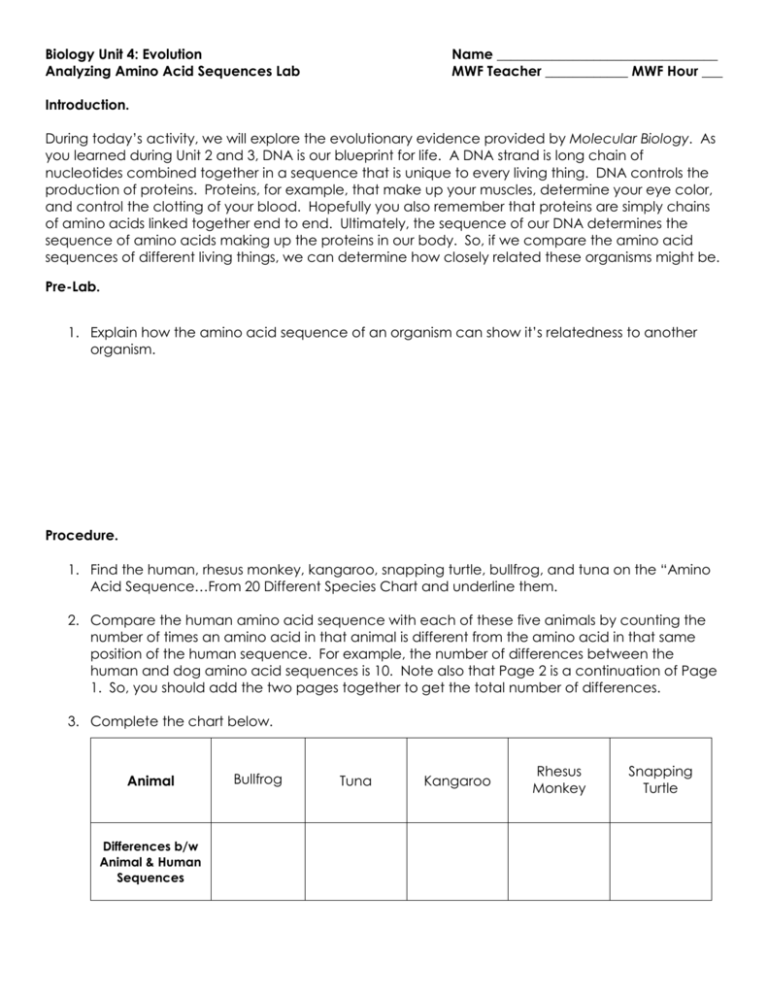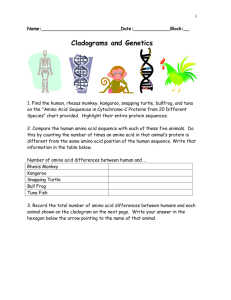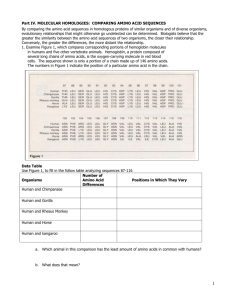Biology Unit 4: Evolution
advertisement

Biology Unit 4: Evolution Analyzing Amino Acid Sequences Lab Name ________________________________ MWF Teacher ____________ MWF Hour ___ Introduction. During today’s activity, we will explore the evolutionary evidence provided by Molecular Biology. As you learned during Unit 2 and 3, DNA is our blueprint for life. A DNA strand is long chain of nucleotides combined together in a sequence that is unique to every living thing. DNA controls the production of proteins. Proteins, for example, that make up your muscles, determine your eye color, and control the clotting of your blood. Hopefully you also remember that proteins are simply chains of amino acids linked together end to end. Ultimately, the sequence of our DNA determines the sequence of amino acids making up the proteins in our body. So, if we compare the amino acid sequences of different living things, we can determine how closely related these organisms might be. Pre-Lab. 1. Explain how the amino acid sequence of an organism can show it’s relatedness to another organism. Procedure. 1. Find the human, rhesus monkey, kangaroo, snapping turtle, bullfrog, and tuna on the “Amino Acid Sequence…From 20 Different Species Chart and underline them. 2. Compare the human amino acid sequence with each of these five animals by counting the number of times an amino acid in that animal is different from the amino acid in that same position of the human sequence. For example, the number of differences between the human and dog amino acid sequences is 10. Note also that Page 2 is a continuation of Page 1. So, you should add the two pages together to get the total number of differences. 3. Complete the chart below. Animal Differences b/w Animal & Human Sequences Bullfrog Tuna Kangaroo Rhesus Monkey Snapping Turtle 4. The diagram below is called a cladogram. It shows the relationship of selected ape species to one another. Find the main line of the cladogram ending in human. The lines branching off (ending in different species of primates) demonstrate how closely (or not closely) related an organism is to humans. As an example, this cladogram shows that chimpanzees, because of their location along the main line, are more closely related to humans than orangutans. 5. Using the data you have gathered about amino acid sequences, complete the cladogram below. Humans have been placed at the end of the cladogram. Write each of the five animals you analyzed above the five remaining arrows. Make sure they are in the appropriate locations. In the hexagons below each arrow, write the number of amino acid differences you found between the animal and a human. Humans Analysis & Conclusions. Answer each question completely. 1. In two or three sentences, summarize the information found in your cladogram. What general pattern(s) does it show? 2. If you were able to compare the amino acid sequences of a duck and a chicken, you would find that there are three amino acid differences. How does the human-monkey relationship compare to the duck-chicken relationship? 3. On Day 1 of the Evolution Unit, you placed yourself on the Spectrum Of Beliefs. What would your school of thought say about this DNA/Amino Acid Evidence? You may need to do some research on the internet!





